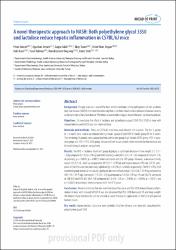| dc.contributor.author | Pinar Gokcen | |
| dc.contributor.author | Oguzhan Ozturk | |
| dc.contributor.author | Gupse Adali | |
| dc.contributor.author | Ilkay Tosun | |
| dc.contributor.author | Halef Okan Dogan | |
| dc.contributor.author | Haki Kara | |
| dc.contributor.author | Yucel Yalman | |
| dc.contributor.author | Hamdi Doganay | |
| dc.contributor.author | Kamil Ozdil | |
| dc.date.accessioned | 2023-04-04T11:12:39Z | |
| dc.date.available | 2023-04-04T11:12:39Z | |
| dc.date.issued | 2021 | tr |
| dc.identifier.uri | https://hdl.handle.net/20.500.12418/13303 | |
| dc.description.abstract | Background. The gut-liver axis is one of the most emphasized topics in the pathogenesis of non-alcoholic fatty liver disease (NAFLD). Intestinal microbiota dysbiosis has been shown to be a predictor of disease severity and progression to fatty liver disease. Therefore, research addressing gut-based therapies has become popular. Objectives. To investigate the effect of lactulose and polyethylene glycol 3350 (PEG 3350) in mice with induced obesity and NAFLD at a non-diarrheal dose. Materials and methods. Thirty-six C57BL/6J male mice were divided into 6 groups. The first 2 groups (n = 6 each) were used as an induced obesity model (group A) and NAFLD model (group B) for 8 weeks. The remaining 24 animals were categorized into control diet group, high-fat diet (HFD) group, HFD + lactulose group, and HFD + PEG 3350 group. Serum and liver tissue samples were obtained for biochemical and histopathological analyses, respectively. Results. The HFD + lactulose treatment group displayed a significant decrease in liver weight (1.3 (1.3- 1.4) kg compared to 1.8 (1.6-1.9) kg) and NAFLD activity score (NAS) (1.5 (1.0-3.0) compared to 5.0 (4.0-5.0), respectively; p = 0.0043, p = 0.0021) when compared with the HFD group. However, a decrease in body weight (35.0 (34.6-36.0) kg compared to 40.9 (34.7-41.9) kg) and hepatosteatosis (HS) rate (33.3% compared to 100.0%) were not statistically significant (p = 0.1796, p = 0.0606, respectively). The HFD + PEG 3350 treatment group showed a statistically significant decrease in body weight (32.4 (30.2-33.9) kg compared to 40.9 (34.7-41.9) kg), liver weight (1.5 (1.3-1.5) kg compared to 1.8 (1.6-1.9) kg), HS rate (16.7% compared to 100.0%) and NAS (0.5 (0.0-1.0) compared to 5.0 (4.0-5.0); p = 0.0086, p = 0.0086, p = 0.0151, and p = 0.0021, respectively) when compared with the HFD group. Conclusions. We demonstrated that non-diarrheal dose of lactulose and PEG 3350 reduced hepatic inflammation in mice with induced NAFLD. It was also observed that PEG 3350 decreased HS and body weight. We believe these mechanisms can be utilized as novel therapeutic approaches in NAFLD in prospective human studies. | tr |
| dc.language.iso | eng | tr |
| dc.relation.isversionof | 10.17219/acem/140506 | tr |
| dc.rights | info:eu-repo/semantics/restrictedAccess | tr |
| dc.subject | hepatosteatosis, lactulose, non-alcoholic fatty liver disease, non-alcoholic steatohepatitis, polyethylene glycol 3350, FATTY LIVER-DISEASE, MICROBIOTA, LAVAGE | tr |
| dc.title | A novel therapeutic approach to NASH: Both polyethylene glycol 3350 and lactulose reduce hepatic inflammation in C57BL/6J mice. | tr |
| dc.type | article | tr |
| dc.contributor.department | Tıp Fakültesi | tr |
| dc.contributor.authorID | 0000-0001-8738-0760 | tr |
| dc.relation.publicationcategory | Uluslararası Hakemli Dergide Makale - Kurum Öğretim Elemanı | tr |















